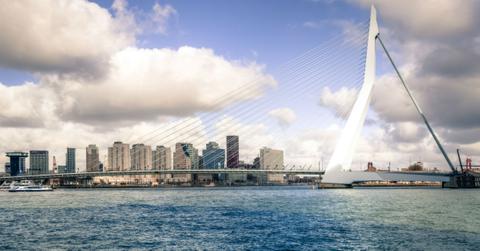Port Of Rotterdam Aims To Cut Emissions By 49% In 2030
The Netherlands hub is using ship tracking technology and hybrid fuel to hit the UN's recommendations.
Updated Oct. 24 2018, 9:45 a.m. ET
Emission reduction goals are usually associated with major companies like Levi’s or McDonald’s, or cities across the globe. They’re less commonly attached to ports, but that hasn’t stopped the port of Rotterdam from setting targets designed to make it a zero emission transit center.
The Dutch harbor is aiming to reduce its carbon emissions from shipping and industry by 49 percent in 2030, ultimately scaling up to a 90 percent reduction in 2050.
Although port emissions fall outside the goals of the Paris Agreement, Rotterdam’s deadlines are in line with targets from the UN’s International Maritime Organization (IMO), according to the Thomas Reuters Foundation. Back in April, the IMO set its first ever shipping emission goals, aiming to cut emissions by at least 50 percent in 2050, using 2008 levels as a baseline. Under the IMO plan, all boats will have to adhere to caps on air pollutants such as sulphur oxide and new ships will have to be 30 percent more energy efficient than those built in 2014 by 2025.
The port of Rotterdam is doing its part by offering financial incentives to ships that run clean. All vessels entering the port are graded on the Environmental Ship Index, a scale which awards them a score out of 100 based on the sulphur oxide, nitrogen oxide, and carbon dioxide they add to the air. The index is completely voluntary, but the highest achievers can earn discounts for their low emissions, which in turn encourages dirtier ships to clean up their act.
The Thomas Reuters Foundation also points to Pronto, a digital tracking platform that provides up-to-date arrivals and departures. It’s meant to reduce waiting times, when ships burn off unnecessary extra carbon, and a port spokesman says it’s already reduced emissions by 20 percent.
But to hit the emission targets, the port of Rotterdam will have to take more drastic actions, including experimentation with electric engines and hybrid fuel. That’s why it’s partnered with Skoon Energy B.V., a startup that makes large rechargeable battery packs for ships. These "Skoonboxes" are compatible with diesel-electric vessels, and once the port establishes a network of charging stations, they’ll expand the possibilities of electric sailing.
Those possibilities will also be boosted through federal funding. This year, Dutch government set aside 1.25 million Euros for "innovative shipping projects," and the financial support is expected to continue in 2019 through a "Green Deal" on sustainable shipping.
Despite the work ahead, port officials are optimistic about their emissions goals.
"A lot is already possible in terms of technology,” Remco Neumann, the corporate social responsibility program manager for the Port of Rotterdam Authority, said in a 2017 press release.
"We already have fully-functional cars that run on hydrogen and solar power for example. Last year saw the first solar flight around the world. It’s now a matter of scaling things up. I’m optimistic about what technology can do for us. Just consider where we stood 30 years ago. We had only just started using PCs at home, there was no internet and cell phones were still pretty exotic. Compare that with the situation today… that’s what we should keep in mind when we’re looking ahead toward 2050."
